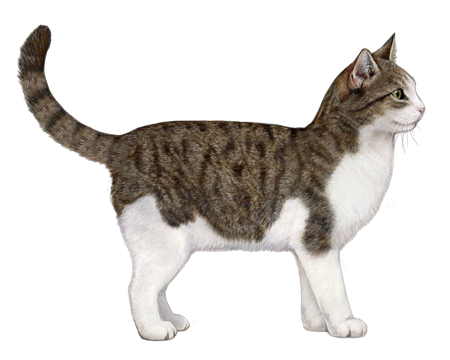
American Curl
American Curls stand out for their adorable curled back ears. But their infectious personality, loving nature, and playful attitude are just as worthy of attention.
Interested in discovering if your cat is an American Curl?
Check out Wisdom Panel's DNA test.
American Curl Traits
General Appearance
American Curls are medium-sized cats with an alert appearance and sweet expression. Their elegant bodies are well-balanced, slender, and moderately muscled. They have round heads, curled-back ears, and walnut-shaped eyes.
Coat and Coloring
The Curl's coat comes in longhair and shorthair varieties. Both types have a fine, silky texture and minimal undercoat, but longhair Curls have a plumed tail. Any combination of colors and coat patterns is possible.
Distinctive Physical Traits
The Curl's unique ears are the breed's trademark feature. All American Curl kittens are born with straight ears that start to curl back after several days. The ears first form tight curls, then gradually unfurl until they reach their permanent position at around four months. The degree of the curl can vary. Some ears are nearly straight, while others form a smooth 90-180 degree arc.
American Curl Temperament
American Curls are people-oriented cats that want to be involved in every aspect of family life. Whether you're watching a movie, making dinner, or taking a shower, Curls will be by your side—just in case you need their help.
These friendly, social cats get along well with other cats, kids, and respectful dogs. They also readily adapt to different surroundings and situations. As long as there are plenty of people around to give them attention, they can be happy just about anywhere.
Curls are known for maintaining their kitten-like playfulness well into adulthood. They also have a curious nature and like to explore every nook and cranny of their environment. Interactive toys, games of fetch, cat trees for climbing, and high places to perch will all keep this lively breed entertained.
Important to note: Curls are early risers. And if they get their way, you will be, too. Gentle taps and head bumps are their preferred ways to subtly (but persistently) let you know it's time to start the day.
American Curl History
All American Curls can trace their ancestry back to a longhaired black kitten with funny-looking ears. Joe and Grace Ruga found this kitten on their doorstep in California in 1981. Noting her peculiar curly ears—and the fact that she clearly needed a meal—they took her in and named her Shulamith.
Shulamith gave birth to a litter six months later, and half of them had her same curly ears. These kittens—and their subsequent litters—captured the attention of cat fanciers and geneticists alike.
The Rugas and their fellow Curl breeders sought recognition of this new breed by the Cat Fancier Association (CFA). Meanwhile, renowned geneticist Roy Robinson began studying data on over 300 Curls to better understand the mutation that led to curled ears. Robinson determined that the ear-curling gene was dominant—meaning only one copy of the gene is needed for the trait to show.
American Curls are a relatively new cat breed. The CFA accepted them for registration in 1986 and granted them Championship status in 1993.
American Curl Care
Nutrition
Curls require a high-quality diet. Because nutritional needs vary for kittens, adults, and senior cats, opt for a formula that's age-appropriate for your pet.
To help your Curl maintain their slender physique, measure out meals and reduce portions if necessary. Also, keep an eye on how many treats you're giving them—especially if giving human food. Just one small piece of cheese can account for half their recommended daily calories. As a guideline, treats should make up no more than 10% of a cat's daily calories.
Finally, all cats need access to fresh, clean water at all times.
Grooming
Shorthair Curls need weekly combing with a soft brush to remove loose fur. Longhair Curls have a lighter undercoat and don't shed as much, but they still require occasional brushing to look their best.
Curls also need weekly ear cleanings to remove wax build-up and regular nail trims. Nails that get too long are more likely to snag on something and become torn or damaged. And overgrown nails can even grow into your cat's paw pads, leading to pain or infection. In addition to clipping, providing a scratching post will allow your cat to do some nail maintenance themselves (thanks to their instinct to scratch).
Like all cats, American Curls should follow a dental care routine that includes at-home teeth brushing and professional dental exams and cleanings.
Health
Roughly one out of every three cats in the United States is overweight or obese. And those extra pounds can contribute to other health risks—such as arthritis, diabetes, and heart problems. Your veterinarian is the best resource for tips on managing your cat's weight.
Breed Group
Western
The largest of breed groups, the Western Group is mainly comprised of cats developed in Europe and the Americas. Due to the complexity of feline genetic diversity, however, cat breeds from other regions may also be found associated with this group.
Resources
https://cfa.org/american-curl/american-curl-article/
https://tica.org/breeds/browse-all-breeds?view=article&id=817:american-curl-breed&catid=79
https://cfa.org/wp-content/uploads/2019/06/american-curl-standard.pdf
https://tica.org/breeds/browse-all-breeds?view=article&id=1205:the-american-curl-breed&catid=48
https://vcahospitals.com/know-your-pet/cat-breeds/american-curl
https://www.banfield.com/state-of-pet-health/obesity
Reviewed February 23, 2021 by Annette Louviere, DVM
























